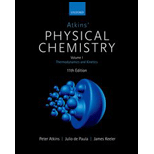
ATKINS' PHYSICAL CHEMISTRY-ACCESS
11th Edition
ISBN: 9780198834700
Author: ATKINS
Publisher: OXF
expand_more
expand_more
format_list_bulleted
Question
Chapter 3, Problem 3D.6P
Interpretation Introduction
Interpretation:
The expressions for
Concept introduction:
The Gibbs free energy of the system represents the maximum amount of non-expansion work achieved by a
Expert Solution & Answer
Want to see the full answer?
Check out a sample textbook solution
Students have asked these similar questions
HELP NOW PLEASE ! URGENT!
HELP NOW PLEASE ! URGENT!
HELP NOW PLEASE ! URGENT!
Chapter 3 Solutions
ATKINS' PHYSICAL CHEMISTRY-ACCESS
Ch. 3 - Prob. 3A.1STCh. 3 - Prob. 3B.1STCh. 3 - Prob. 3C.1STCh. 3 - Prob. 3D.1STCh. 3 - Prob. 3D.2STCh. 3 - Prob. 3E.1STCh. 3 - Prob. 3E.2STCh. 3 - Prob. 3E.3STCh. 3 - Prob. 3A.1DQCh. 3 - Prob. 3A.2DQ
Ch. 3 - Prob. 3A.1AECh. 3 - Prob. 3A.1BECh. 3 - Prob. 3A.2AECh. 3 - Prob. 3A.2BECh. 3 - Prob. 3A.3AECh. 3 - Prob. 3A.3BECh. 3 - Prob. 3A.4AECh. 3 - Prob. 3A.4BECh. 3 - Prob. 3A.5AECh. 3 - Prob. 3A.5BECh. 3 - Prob. 3A.6AECh. 3 - Prob. 3A.6BECh. 3 - Prob. 3A.1PCh. 3 - Prob. 3A.2PCh. 3 - Prob. 3A.3PCh. 3 - Prob. 3A.4PCh. 3 - Prob. 3A.5PCh. 3 - Prob. 3A.6PCh. 3 - Prob. 3A.7PCh. 3 - Prob. 3B.1DQCh. 3 - Prob. 3B.1AECh. 3 - Prob. 3B.1BECh. 3 - Prob. 3B.2AECh. 3 - Prob. 3B.2BECh. 3 - Prob. 3B.3AECh. 3 - Prob. 3B.3BECh. 3 - Prob. 3B.4AECh. 3 - Prob. 3B.4BECh. 3 - Prob. 3B.5AECh. 3 - Prob. 3B.5BECh. 3 - Prob. 3B.6AECh. 3 - Prob. 3B.6BECh. 3 - Prob. 3B.7AECh. 3 - Prob. 3B.7BECh. 3 - Prob. 3B.1PCh. 3 - Prob. 3B.2PCh. 3 - Prob. 3B.3PCh. 3 - Prob. 3B.4PCh. 3 - Prob. 3B.5PCh. 3 - Prob. 3B.6PCh. 3 - Prob. 3B.7PCh. 3 - Prob. 3B.8PCh. 3 - Prob. 3B.9PCh. 3 - Prob. 3B.10PCh. 3 - Prob. 3B.12PCh. 3 - Prob. 3C.1DQCh. 3 - Prob. 3C.1AECh. 3 - Prob. 3C.1BECh. 3 - Prob. 3C.2AECh. 3 - Prob. 3C.2BECh. 3 - Prob. 3C.3AECh. 3 - Prob. 3C.3BECh. 3 - Prob. 3C.1PCh. 3 - Prob. 3C.2PCh. 3 - Prob. 3C.4PCh. 3 - Prob. 3C.5PCh. 3 - Prob. 3C.6PCh. 3 - Prob. 3C.7PCh. 3 - Prob. 3C.8PCh. 3 - Prob. 3C.9PCh. 3 - Prob. 3C.10PCh. 3 - Prob. 3D.1DQCh. 3 - Prob. 3D.2DQCh. 3 - Prob. 3D.1AECh. 3 - Prob. 3D.1BECh. 3 - Prob. 3D.2AECh. 3 - Prob. 3D.2BECh. 3 - Prob. 3D.3AECh. 3 - Prob. 3D.3BECh. 3 - Prob. 3D.4AECh. 3 - Prob. 3D.4BECh. 3 - Prob. 3D.5AECh. 3 - Prob. 3D.5BECh. 3 - Prob. 3D.1PCh. 3 - Prob. 3D.2PCh. 3 - Prob. 3D.3PCh. 3 - Prob. 3D.4PCh. 3 - Prob. 3D.5PCh. 3 - Prob. 3D.6PCh. 3 - Prob. 3E.1DQCh. 3 - Prob. 3E.2DQCh. 3 - Prob. 3E.1AECh. 3 - Prob. 3E.1BECh. 3 - Prob. 3E.2AECh. 3 - Prob. 3E.2BECh. 3 - Prob. 3E.3AECh. 3 - Prob. 3E.3BECh. 3 - Prob. 3E.4AECh. 3 - Prob. 3E.4BECh. 3 - Prob. 3E.5AECh. 3 - Prob. 3E.5BECh. 3 - Prob. 3E.6AECh. 3 - Prob. 3E.6BECh. 3 - Prob. 3E.1PCh. 3 - Prob. 3E.2PCh. 3 - Prob. 3E.3PCh. 3 - Prob. 3E.4PCh. 3 - Prob. 3E.5PCh. 3 - Prob. 3E.6PCh. 3 - Prob. 3E.8PCh. 3 - Prob. 3.1IACh. 3 - Prob. 3.2IA
Knowledge Booster
Similar questions
- HELP NOW PLEASE ! ASAP! URGENT!arrow_forwardHELP NOW PLEASE ! ASAP! URGENT!arrow_forwardDraw a Newman projection for the molecule below from the perspective indicated. Which of the groups (letters A-H) are methyl groups? CH3 H H H A H B ☑ >> H. ABCDEFG I H -H CH3 G D CH F E Numeric 4 points How many gauche interactions exist in the conformation shown in the previous problem? 1arrow_forward
- HELP NOW PLEASE ! ASAP! URGENT!arrow_forwardHELP NOW PLEASE ! ASAP! URGENT!arrow_forwardWould the following organic synthesis occur in one step? Add any missing products, required catalysts, inorganic reagents, and other important conditions. Please include a detailed explanation and drawings showing how the reaction may occur in one step.arrow_forward
- Pls help.arrow_forward13) When solid barium phosphate is in equilibrium with its ions, the ratio of barium ions to phosphate ions would be: a. 1:1 b. 2:3 c. 3:2 d. 2:1 14) The pH of a 0.05 M solution of HCl(aq) at 25°C is 15) The pH of a 0.20 M solution of KOH at 25°C isarrow_forwardPls help.arrow_forward
- Pls help.arrow_forward16) A 2.0 L flask containing 2.0 x 10-3 mol H2(g), 3.0 x 10-3 mol Cl2(g), and 4.0 x 10-3 mol HCl(g) at equilibrium. This system is represented by the following chemical equation: H2 (g) + Cl2 (g) → 2HCl(g) Calculate the equilibrium constant for this reaction.arrow_forward7) The pH of a 0.05M solution of HCl(aq) at 25°C is a. 1.3 b. 2.3 c. 3.3 d. 12.7arrow_forward
arrow_back_ios
SEE MORE QUESTIONS
arrow_forward_ios
Recommended textbooks for you
 ChemistryChemistryISBN:9781305957404Author:Steven S. Zumdahl, Susan A. Zumdahl, Donald J. DeCostePublisher:Cengage Learning
ChemistryChemistryISBN:9781305957404Author:Steven S. Zumdahl, Susan A. Zumdahl, Donald J. DeCostePublisher:Cengage Learning ChemistryChemistryISBN:9781259911156Author:Raymond Chang Dr., Jason Overby ProfessorPublisher:McGraw-Hill Education
ChemistryChemistryISBN:9781259911156Author:Raymond Chang Dr., Jason Overby ProfessorPublisher:McGraw-Hill Education Principles of Instrumental AnalysisChemistryISBN:9781305577213Author:Douglas A. Skoog, F. James Holler, Stanley R. CrouchPublisher:Cengage Learning
Principles of Instrumental AnalysisChemistryISBN:9781305577213Author:Douglas A. Skoog, F. James Holler, Stanley R. CrouchPublisher:Cengage Learning Organic ChemistryChemistryISBN:9780078021558Author:Janice Gorzynski Smith Dr.Publisher:McGraw-Hill Education
Organic ChemistryChemistryISBN:9780078021558Author:Janice Gorzynski Smith Dr.Publisher:McGraw-Hill Education Chemistry: Principles and ReactionsChemistryISBN:9781305079373Author:William L. Masterton, Cecile N. HurleyPublisher:Cengage Learning
Chemistry: Principles and ReactionsChemistryISBN:9781305079373Author:William L. Masterton, Cecile N. HurleyPublisher:Cengage Learning Elementary Principles of Chemical Processes, Bind...ChemistryISBN:9781118431221Author:Richard M. Felder, Ronald W. Rousseau, Lisa G. BullardPublisher:WILEY
Elementary Principles of Chemical Processes, Bind...ChemistryISBN:9781118431221Author:Richard M. Felder, Ronald W. Rousseau, Lisa G. BullardPublisher:WILEY

Chemistry
Chemistry
ISBN:9781305957404
Author:Steven S. Zumdahl, Susan A. Zumdahl, Donald J. DeCoste
Publisher:Cengage Learning

Chemistry
Chemistry
ISBN:9781259911156
Author:Raymond Chang Dr., Jason Overby Professor
Publisher:McGraw-Hill Education

Principles of Instrumental Analysis
Chemistry
ISBN:9781305577213
Author:Douglas A. Skoog, F. James Holler, Stanley R. Crouch
Publisher:Cengage Learning

Organic Chemistry
Chemistry
ISBN:9780078021558
Author:Janice Gorzynski Smith Dr.
Publisher:McGraw-Hill Education

Chemistry: Principles and Reactions
Chemistry
ISBN:9781305079373
Author:William L. Masterton, Cecile N. Hurley
Publisher:Cengage Learning

Elementary Principles of Chemical Processes, Bind...
Chemistry
ISBN:9781118431221
Author:Richard M. Felder, Ronald W. Rousseau, Lisa G. Bullard
Publisher:WILEY